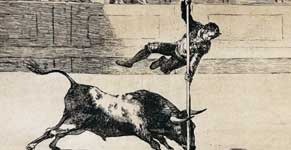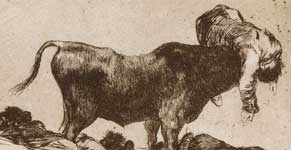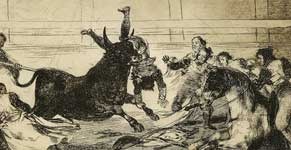Tauromaquia
Goya released his third great series of etchings for sale, Tauromaquia (“Bullfighting”), in 1816. He had been a great fan of bullfighting from an early age. Bullfights and bull runs experienced a great resurgence after the war and Goya did not miss the chance to earn some money, but the series did not sell as well as the painter had hoped.
Compared to other series of etchings of bulls like that of Antonio Carnicero, which were merely descriptive, Goya wanted to capture in pictures a history of bullfighting in Spain, in chronological order from the Middle Ages to the most famous toreros of his era, like Antonio Ebassun “Martincho”, from Aragon, José Delgado “Pepe-Illo”, from Seville, and Pedro Romero, the torero from Ronda that he so admired.
He also reflected the different “types” of bullfighting, the moments of triumph of the skilled, and even the mishaps and misfortunes that could occur during the fight. An intense dramatic quality, achieved through great technical virtuosity, is seen in all the prints of the series, but people were unable to appreciate the quality and artistic value of Tauromaquia and preferred other, more conventional images of bullfighting.





